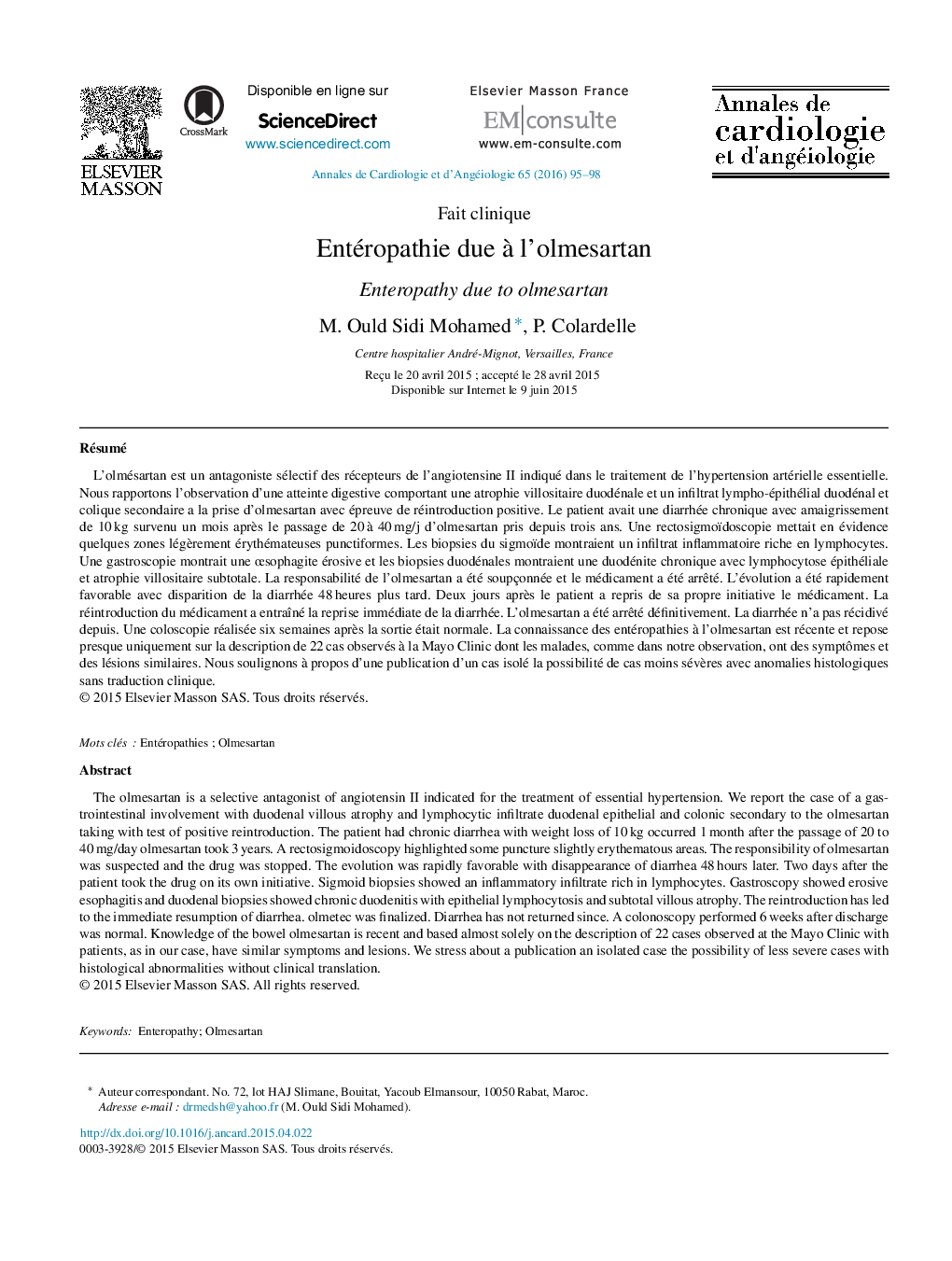| Article ID | Journal | Published Year | Pages | File Type |
|---|---|---|---|---|
| 2868540 | Annales de Cardiologie et d'Angéiologie | 2016 | 4 Pages |
RésuméL’olmésartan est un antagoniste sélectif des récepteurs de l’angiotensine II indiqué dans le traitement de l’hypertension artérielle essentielle. Nous rapportons l’observation d’une atteinte digestive comportant une atrophie villositaire duodénale et un infiltrat lympho-épithélial duodénal et colique secondaire a la prise d’olmesartan avec épreuve de réintroduction positive. Le patient avait une diarrhée chronique avec amaigrissement de 10 kg survenu un mois après le passage de 20 à 40 mg/j d’olmesartan pris depuis trois ans. Une rectosigmoïdoscopie mettait en évidence quelques zones légèrement érythémateuses punctiformes. Les biopsies du sigmoïde montraient un infiltrat inflammatoire riche en lymphocytes. Une gastroscopie montrait une œsophagite érosive et les biopsies duodénales montraient une duodénite chronique avec lymphocytose épithéliale et atrophie villositaire subtotale. La responsabilité de l’olmesartan a été soupçonnée et le médicament a été arrêté. L’évolution a été rapidement favorable avec disparition de la diarrhée 48 heures plus tard. Deux jours après le patient a repris de sa propre initiative le médicament. La réintroduction du médicament a entraîné la reprise immédiate de la diarrhée. L’olmesartan a été arrêté définitivement. La diarrhée n’a pas récidivé depuis. Une coloscopie réalisée six semaines après la sortie était normale. La connaissance des entéropathies à l’olmesartan est récente et repose presque uniquement sur la description de 22 cas observés à la Mayo Clinic dont les malades, comme dans notre observation, ont des symptômes et des lésions similaires. Nous soulignons à propos d’une publication d’un cas isolé la possibilité de cas moins sévères avec anomalies histologiques sans traduction clinique.
The olmesartan is a selective antagonist of angiotensin II indicated for the treatment of essential hypertension. We report the case of a gastrointestinal involvement with duodenal villous atrophy and lymphocytic infiltrate duodenal epithelial and colonic secondary to the olmesartan taking with test of positive reintroduction. The patient had chronic diarrhea with weight loss of 10 kg occurred 1 month after the passage of 20 to 40 mg/day olmesartan took 3 years. A rectosigmoidoscopy highlighted some puncture slightly erythematous areas. The responsibility of olmesartan was suspected and the drug was stopped. The evolution was rapidly favorable with disappearance of diarrhea 48 hours later. Two days after the patient took the drug on its own initiative. Sigmoid biopsies showed an inflammatory infiltrate rich in lymphocytes. Gastroscopy showed erosive esophagitis and duodenal biopsies showed chronic duodenitis with epithelial lymphocytosis and subtotal villous atrophy. The reintroduction has led to the immediate resumption of diarrhea. olmetec was finalized. Diarrhea has not returned since. A colonoscopy performed 6 weeks after discharge was normal. Knowledge of the bowel olmesartan is recent and based almost solely on the description of 22 cases observed at the Mayo Clinic with patients, as in our case, have similar symptoms and lesions. We stress about a publication an isolated case the possibility of less severe cases with histological abnormalities without clinical translation.
